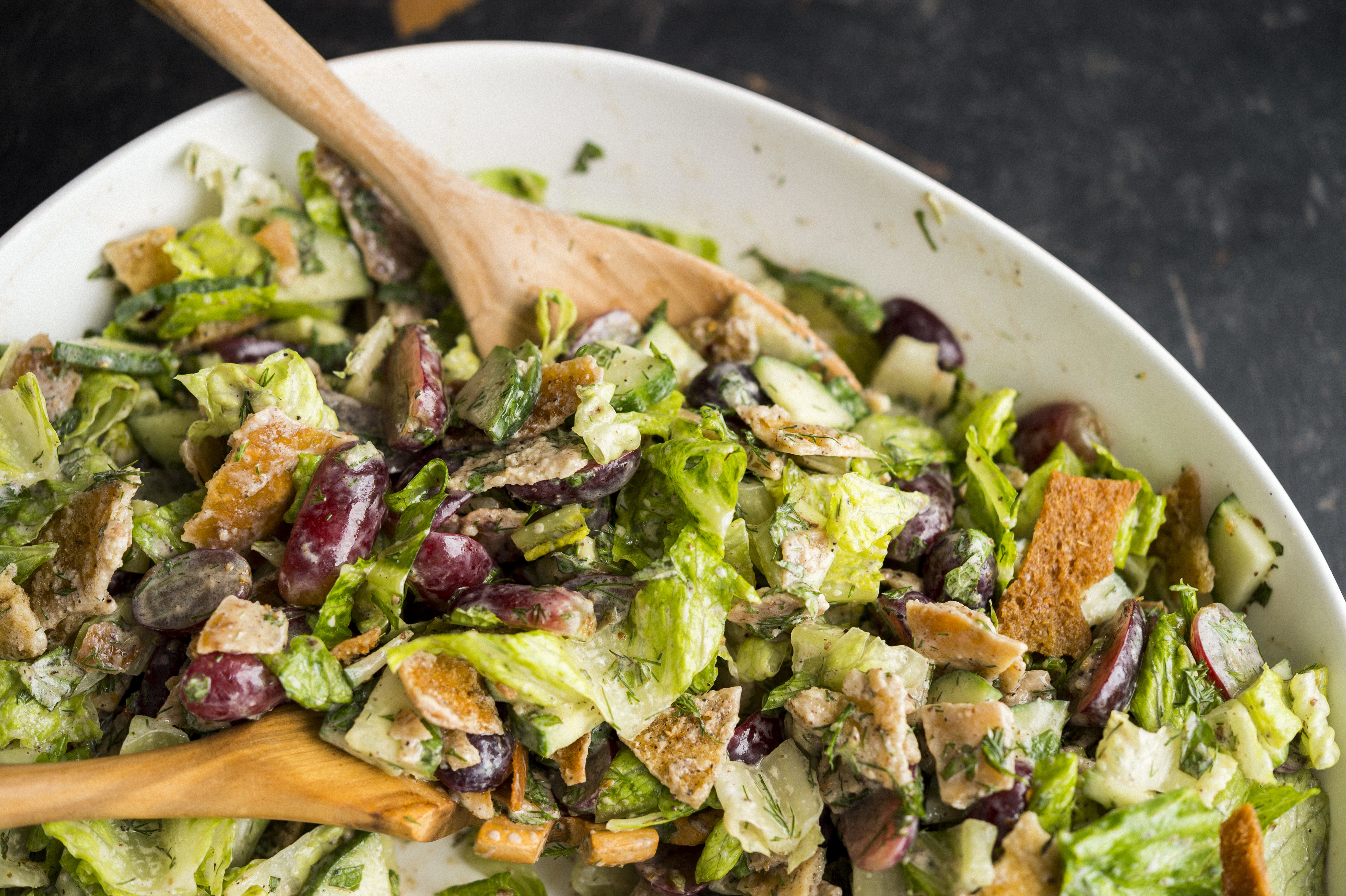For most Americans, the mention of bread salad calls to mind panzanella, Tuscany’s solution for stale bread. But fresh, thin flatbreads dry out even faster than foccacia—there’s a greener, crunchier cousin of panzanella: fattoush.
In some ways, fattoush is little more than a chopped salad, not terribly dissimilar from the ubiquitous Arab salad that accompanies meals in the Middle East. A variable mix of cucumber, radish, lettuce, tomatoes, scallions and fresh herbs forms its backbone.
But two ingredients set fattoush apart—sumac and pita bread.
Sumac, a fruity, lemony Levantine spice, is sprinkled over the salad and whisked into its dressing by the tablespoon, adding pronounced tang to each bite. Pita is mandatory, sometimes deep-fried, sometimes toasted or simply stale. The bread adds heft to the salad; the sumac gives it its signature flavor.
Like many simple dishes, every cook’s version of fattoush is different. Claudia Roden notes that early recipes called for soaking the stale pita rather than crisping it like croutons. Cookbook author Anissa Helou has encountered versions in Lebanon that included green peppers, chili oil, even cabbage. At Milk Street, we came across an unconventional fattoush that was much closer to home.
Beneath the canopy of a fig tree, on a brick patio illuminated with strung lights, diners at Oleana have for 16 years sampled Mediterranean and Middle Eastern fare turned out by chef Ana Sortun in Cambridge, Massachusetts. Though the offerings span the familiar (grilled pita, falafel, kebab) and foreign (borek, fatteh, cacik), whatever emerges from Oleana’s kitchen has Sortun’s distinct stamp on it—a slight departure from the expected.
She swaps in parsnips for chickpeas in hummus. She simmers fideos, the saffron-tinged vermicelli noodle-and-seafood dish from Spain, with vanilla bean and cocoa powder. She uses baby beets to make tzatziki.
The same goes for fattoush, which Sortun says she had “upside down and sideways” in her travels in Lebanon. “Chopped, not so chopped. Lots of sumac, not so much sumac. It’s just a really basic salad and it’s a really great way to use leftover pita bread, too.”
Typical ingredients like cucumber, romaine and radish appear in Oleana’s renditions of fattoush, but “we also like to throw in the surprise of something really sweet and tart,” she says.

That sweet, tart surprise? Fruit. Green apples, strawberries, clementines and red grapes have at various times anchored Oleana’s fattoush.
The chopped fruit is dressed in an emulsion of lemon juice, olive oil, sherry vinegar, mustard and a little honey, then it sits in the vinaigrette. “They’re marinated just a couple of hours,” Sortun says. The fruit takes on a lightly pickled quality in that time, building on the flavors traditionally found in the salad.
“What we took from the fattoush,” Sortun says, “was that it was really tart from the sumac and sometimes from the pomegranate molasses,” the dense, tart and slightly sweet condiment made by concentrating the juice of sour pomegranates. “Sometimes I think that tartness is really nice from whatever fruit.”
We were most struck by the pickled red grape fattoush we tried at Oleana—the juicy, tangy grapes contrasted wonderfully with the crisp pita crumbles. These slightly sour grapes, we discovered, provide the same sweet, acidic taste as the best tomatoes.
“The fruit takes the place of the tomatoes,” Sortun says. “We never use tomatoes.” She chalks that up to the limited tomato season, but at Milk Street we often puzzle over the best substitute for lackluster store-bought tomatoes.
For our fattoush, we started by streamlining the marinade for the grapes. Rather than combining them with an emulsion, we used ¼ cup of cider vinegar and a little salt. The halved red seedless grapes developed a slight acidity in the time it took to toast the pita.
We took one more lesson from Sortun—making the pita extra-crispy. “They should shatter in your teeth,” she says. “If you really oil [the pita] evenly as you toast, so that they almost fry, then you get these little crisps.”
To ensure the right texture, we started with fresh pita. We tore open the rounds and brushed the rough interior (which absorbs oil better than the smooth exterior) with 6 tablespoons of extra- virgin olive oil seasoned with garlic, cumin and red pepper flakes.
We made a simple dressing with fresh dill, oil and yogurt, then finished it with the grapes’ pickling liquid. To minimize the amount of chopping, we left radish out of the recipe. A full pound of grapes—plus cucumber, romaine and a cup of mint—yielded enough salad for a crowd.
We loved the dimension that sumac and pomegranate molasses gave to the fattoush: The sumac adds a citrusy flavor without making it soggy, and the tart-yet-sweet pomegranate molasses at once underscores and balances that. But we also knew neither ingredient is a staple in American kitchens (yet).
So we tried our recipe with and without them. Though the version that included the sumac and molasses was better, both salads were summarily devoured by Milk Street’s staff. We saw the same results at our own dinner tables, too.




